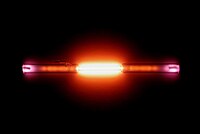
Photo from wikipedia
The cloud point extraction (CPE) method was successfully used for the isolation and pre-concentration of ultra-low concentration of Pb prior to its determination by flame atomic absorption spectrometry (FAAS). Lead(II)… Click to show full abstract
The cloud point extraction (CPE) method was successfully used for the isolation and pre-concentration of ultra-low concentration of Pb prior to its determination by flame atomic absorption spectrometry (FAAS). Lead(II) reacts with methyl 4,20-diisobutyl-2,5,8,16,19,22- hexaoxo-7,17-dipropyl-3,6,9,15,18,21-hexaaza-1(2,6)-pyridinacyclo-docosaphane-10-carboxylate (DLNL) as chelating agent in the presence of octylphenoxypolyethoxyethanol (Triton X-114) as a nonionic surfactant giving a surfactant-rich phase chelate which could be used for CPE. Factors affecting the CPE such as solution pH, concentrations of the chelating ligand and surfactant, temperature of equilibration, and time were optimized. The efficacy features of the proposed protocol such as linear range, lower limit of detection, pre-concentration, and progress factors were evaluated. The method revealed a wide linear range in the range of 7–250 ng/mL of Pb2+ with a limit of detection of 5 ng/mL using FAAS. Validation of the presented protocol revealed good performance characteristics including high between-batch repeatability, high precision, wide linear range, low limit of detection, and acceptable accuracy. The presented procedure was successfully introduced for the separation and quantification of lead (II) in wastewater samples with acceptable results.
Journal Title: Applied Sciences
Year Published: 2019
Link to full text (if available)
Share on Social Media: Sign Up to like & get
recommendations!